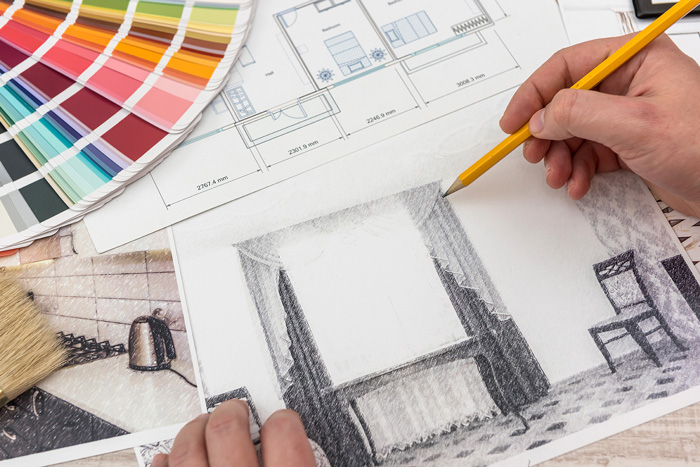Breaking Through Creative Burnout
22 invigorating ideas for taking care of yourself and your creative health

This article appears in Issue 15 of CreativePro Magazine.
Although creative burnout is remarkably common, people often suffer through it in quiet solitude. Perhaps you have hesitated to seek help because you feel ashamed, as though you have failed somehow by no longer being as passionate about the work as you used to be. Perhaps you fear that your career has peaked and you can never regain your verve. Perhaps you are experiencing a crippling sense of powerlessness.
But creative burnout is not a sign of failure, ineptitude, or weakness—it is a sign of misalignment and fatigue.
And it is not permanent. You can change your situation.
Are You Burned Out?

People experience creative burnout differently. While one person might feel burned out from too much work, another might feel it from unvarying and creatively stifling duties, and still another might feel it from being stuck in a single, seemingly never-ending project.
Beyond workload, burnout can be caused by one’s environment, by unreasonable demands or toxic treatment from bosses or clients, by peer pressure from social media or in real life, and by high expectations of oneself.
Signs of burnout vary, too. The common thread is prolonged imbalance between what inspires, energizes, and supports your creativity and your day-to-day reality.
Common signs of creative burnout
Here are some common symptoms of creative burnout. Do you recognize any of them in yourself?
- Feeling low energy or fear at the prospect of creating something
- Dreading work or procrastinating on tasks you used to enjoy
- Being more impatient and more easily annoyed than usual
- Feeling ashamed about the quantity or quality of your work
- Not caring about details that you used to care about
- A feeling of emptiness, loneliness, and deep dissatisfaction at the end of your workday
- Repeated doubts about your competency, judgment, and potential
- Difficulty coming up with new ideas
- Viewing the future of your career with a sense of resignation or helplessness
- Stiffness and aching in parts of your body where you store tension, such as your back, neck, and shoulders
- Poor sleep and nightmares about work
- Cynical thoughts about the importance of your work or the creative industry in general
Symptoms of carpal tunnel syndrome, cubital tunnel syndrome, or other physical overuse injuries might be additional clues that your body needs better care.
Help is out there
If you are experiencing some of these signs, it is possible you are creatively burned out. Fear not—help is on the way!
22 Ideas to Help Overcome Creative Burnout
Here are some specific steps you can take to mitigate the symptoms of burnout.
Use a pie chart to identify your major stressors. You’re accustomed to using your design skills to communicate with others, so why not use them to understand yourself better? Create a pie chart and add a wedge for every issue in your life that is causing you stress or draining your energy. Each wedge should be sized proportionally to the amount of impact it is having on you. You’ll immediately get a clearer picture of what is occupying your attention.
This technique alone can significantly reduce your sense of being overwhelmed; you may find that only three things—not “everything” in your life—are causing most of your stress. The chart can then help you to identify what to address first or where easier wins might be.
Nurture your belief in yourself. Your confidence and self-esteem can be early casualties of creative burnout.
- Make a list of past challenges that you overcame or times when you succeeded against the odds.
- Review projects that you’re proud of and, if you wish, give them a boost on social media.
- Read testimonials from colleagues and clients, or ask for some.
- Write positive affirmations about your abilities and value as a creative human, and post them where you’ll see them every day.
Say “no” or “not right now.” When you’re burned out, avoid additional work that won’t spark joy. Politely decline such prospects; a gentler “not now” can leave the door open. Perhaps you can redirect the work to someone better positioned to attend to it. Either way, protect your focus and energy (and possibly serve your prospect better) by saying no.
If you aren’t in a position to decline work, ask for help or offer to mentor someone else on the project. And if that’s not possible, try to delegate your other tasks so you have enough bandwidth to take on the new project.
Coach yourself. Try writing a letter or email to yourself from a future you—one who is older and wiser. This exercise can often reveal brilliant advice or words of support perfectly tailored to your circumstances.
Hire an expert. The causes and effects of creative burnout are not limited to our professional work. A tangle of traumas and intense, difficult emotions may be underlying the burnout. A licensed therapist or trained career coach can help you address such issues and overcome severe burnout faster than you can alone. Consider the time commitment and cost as an investment in both your career and your well-being.
Help someone who is earlier in their career. Mentor someone or volunteer to give a presentation at your local high school or community college about what you do in your job. Many art and design teachers are thrilled for their students to hear from a working professional.

You’ll benefit, too. What you’ve come to think is humdrum and obvious may be fascinating when seen through a beginner’s eyes. Enthusiasm is contagious, and in uplifting others, you can uplift yourself.
Fill your workspace with positivity. Our environments can inspire us, distract us, or keep us in a rut, and as creative professionals, we need environments that stimulate creative flow. Assess your working space with a critical eye and take action:
- Clear away the clutter (or leave just the right amount).
- Put up motivating or funny quotes.
- Hang photos of your heroes at work.
- Add fresh flowers or a backdrop in a color that brings you joy.
- If you work from home, try adding scents with candles, incense, or an essential oil diffuser. (There is some evidence that peppermint scents can improve focus.)

Consider the sounds you allow to enter your space.
- A white noise machine or noise-canceling headphones can help mask away traffic or construction noise.
- A quick search on YouTube will provide endless hours of calm background music, some with subliminal messaging meant to program your brain to think more positively.
Find the funny side. Laughing feels good and can help you relax. If you had a frustrating day, instead of complaining to your friend, show them an interpretive dance of how your day went. (Do “The Software Crash” and repeat it for “Another Round of Revisions”!)
If nothing else, drink your tea with your pinky sticking out, for you are very fancy to have so many “designer” problems (as opposed to cheap, generic problems). No one on the Zoom call needs to know why you’re doing this—or maybe they do, and they can have a chuckle, too.
Write a manifesto to redefine your boundaries and purpose. An unsustainable workload, prolonged microabuses at work, and working continuously on projects that don’t interest you can all contribute to burnout.
Writing a statement about what you stand for as a creative professional can help you gain clarity on your standards for your career and ground your future actions in the values that matter most to you. Try flipping through a copy of You Need a Manifesto: How to Craft Your Convictions and Put Them to Work, by Charlotte Burgess-Auburn, to get started.
Design something for a fictional client. Don’t wait for that dream project to come to you. Make your own dream projects come true, or at least a mini version of them.
For example, if you’ve always wanted to design packaging for a chocolate company, block out a window of time to design a label in your favorite flavor. (Bonus points if you print it out, wrap it around a real chocolate bar, and give it to a friend.)
Share your just-for-fun creation online. Who knows? Your ideal client may notice and come knocking.
Create something off-screen. If you haven’t designed anything without pixels for a while, make time to do so. Working with your hands and holding a physical object that you made can reignite your creative spirit. You don’t even need to buy supplies; you likely have plenty of materials around your house. Put the emphasis on fun (or even be outright silly); this is play, not work!
- Sculpt with salt dough (clay made of flour, salt, and water and baked in an oven).
- Invent a typeface made of twigs.
- Decorate sugar cookies in the style of your favorite design era.
- Produce a stop-motion video using your smartphone and gummy bears.
- Fold paper airplanes and find out which design flies the farthest.
- Bind your own notebook or sketchbook.
- Carve patterns into a bar of soap.
- Use sticky notes to create a flip book about a day in your life.
- Open an ink pad and make thumbprint animals.
Visit an art supply store. Simply surrounding yourself with an array of new craft materials can be enough to start up a creative itch. Buy something you wouldn’t usually, and make something with it right away.

Schedule time for gathering inspiration. Creative burnout can happen when we create, create, create and neglect to refill our reserves. It’s an investment in your creative self to seek out what others have been creating, whether by browsing sites like Behance or Pinterest, or by wandering through museums and shops.
Audit your content consumption. As the saying goes, “garbage in, garbage out.” Are you feeding your mind engaging content? Or have you been mostly watching silly TV dramas and scrolling through random Instagram reels? Is that content entertaining you and helping you recharge, or are you simply consuming it out of boredom and habit?
Decide on the right balance of vegetables and junk food for yourself, content-wise.
Learn a new design technique. Gaining a new skill or technique feels empowering. In the slump of a burnout, you may not feel motivated to learn something new, but doing so can spark your curiosity and help you move forward with fresh enthusiasm and confidence. Do you know how to make hexagonal patterns in Illustrator or create a wax-seal effect in Photoshop? Design software evolves quickly, offering ways for us to accomplish things we haven’t imagined before. See what’s possible today.
Relearn something. If there is one positive side to the insecurity that can accompany creative burnout, it is that your mind may be more open to relearning.
- Dive back into color theory.
- Read up on grid systems.
- Crack open your copy of The Elements of Typographic Style and brush up on Robert Bringhurst’s recommendations for best practices in typesetting.
Reminding yourself of design fundamentals might just make you fall back in love with the craft.

Approach a familiar task with new eyes. Find ways to experience your work differently.
- Rotate your view of an InDesign layout 180 degrees and see if you can design a layout upside-down (View > Rotate Spread > 180°).
- Try working in one of the two color-blind modes in Illustrator (View > Proof Setup) before switching to your standard color mode.
Ensure that you have something to look forward to every day. During a creative burnout, it may feel as though you lack influence, days are repetitive, and life is bleak. Every day, make sure there is at least one thing you can anticipate that is within your control. This can be as simple as a cup of coffee from your favorite café or a 10-minute yoga session before bed.
Reflect with gratitude. Remind yourself of how supported and valued you are by making a few lists. These will also help you see that positive changes are brewing.
- List at least three people who have helped your professional development.
- List at least three people who have appreciated your creativity.
- List at least three resources available to support your growth or help you achieve your goals.
- List at least three things that went smoothly this week.
Study the careers of famous creatives. Beneath an iceberg of brilliant results you’ll find a tremendous amount of unglamorous struggle, quiet practice, and bitter adversity. Discover the obstacles that other creatives confronted and see how they navigated them to achieve their creative potential and leave their legacy.
Mastery by Robert Greene is filled with stories of how great creatives of all stripes achieved excellence in their work.
Connect with other creatives. All creative professionals, from designers to photographers, writers, illustrators, animators, and videographers, experience ups and downs. For many of us, a large portion of our work is done in relative solitude. We constantly handle criticisms and opinions (solicited and not) about our work. We know the thrill of making beautiful work and the frustration of not being able to. We feel this in a way that people who aren’t professional creatives will not understand.
This is why it’s so refreshing, affirming, and humanizing to connect with other creatives. Attend conferences (like CreativePro events). Go to craft fairs and talk with the artisans. Make friends in online communities.
The creative journey is full of challenges, but having sympathetic friends who will laugh with you at design memes or gripe with you about the latest software “update” can help a lot.
Take a break. Burnout is often a sign that your mind needs rest or a significant change.
A short break might be a walk around the block or a five-minute meditation session.
A medium break might be taking a week-long vacation. A long break might be a year-long sabbatical.
Whatever you choose, remember that if you keep stressing out about work while you are on your break, you are not really taking a break. You are just being stressed elsewhere.
Do your best to stay present on breaks. Set up out-of-office auto-replies for your email, and turn off notifications on all work-related apps. Create a time and place to reflect on what you need to thrive as a creative human, and decide how you will redesign your life to make those essentials abundant for yourself.
A New Day Awaits
Creative burnout is difficult, but you can overcome it with patience, self-compassion, and the courage to change existing patterns. When you regain your spark and drive, a new chapter of your career will begin.

Commenting is easier and faster when you're logged in!
Recommended for you

Masking Artwork in Illustrator
Create clipping and opacity masks to fill your artwork with anything

All About Indents and Other Paragraph Separators
Learn how to choose the right method of paragraph separations to add both readab...

Animate and Schedule Your Content with Adobe Express
Maximize your marketing productivity while staying on brand.




